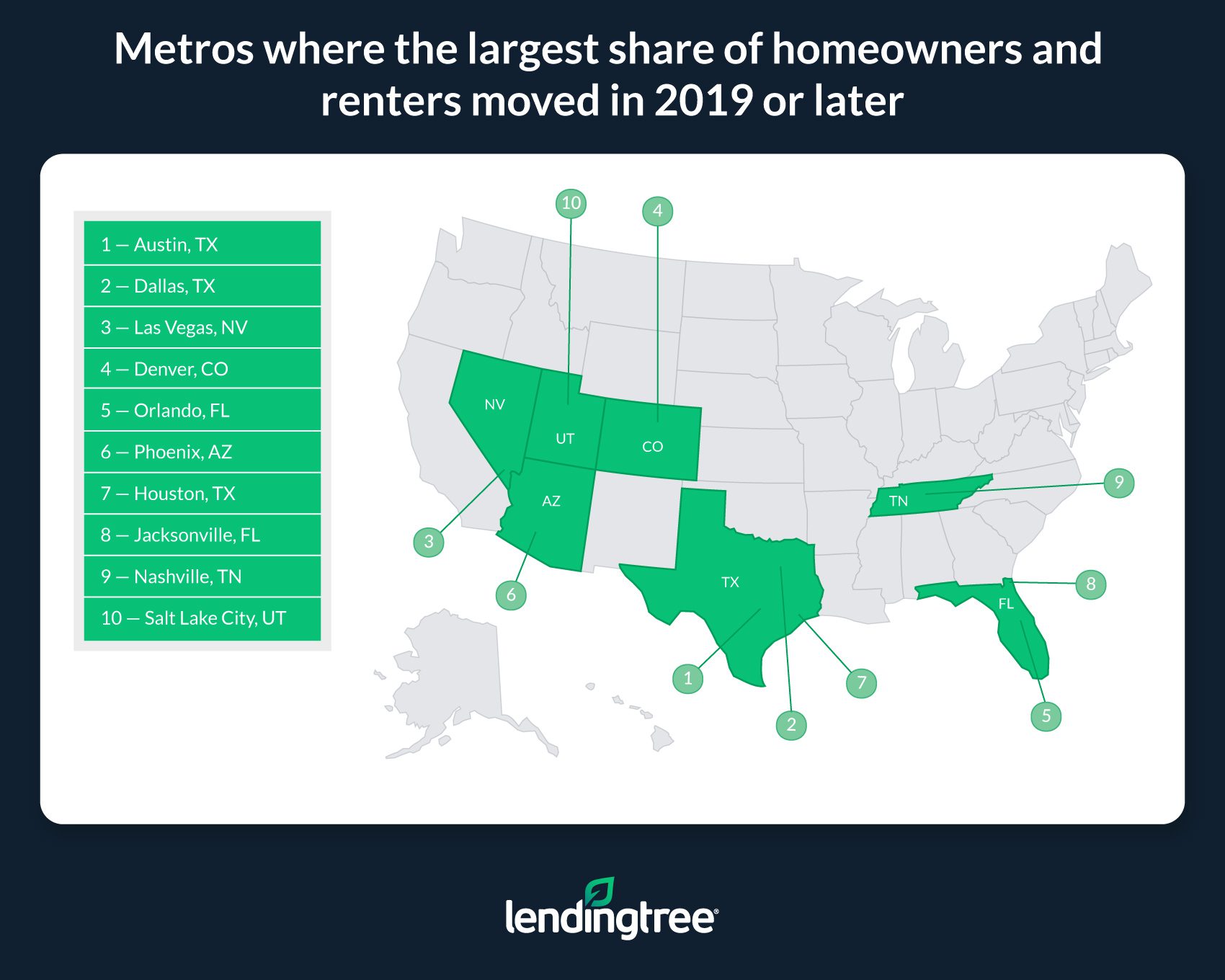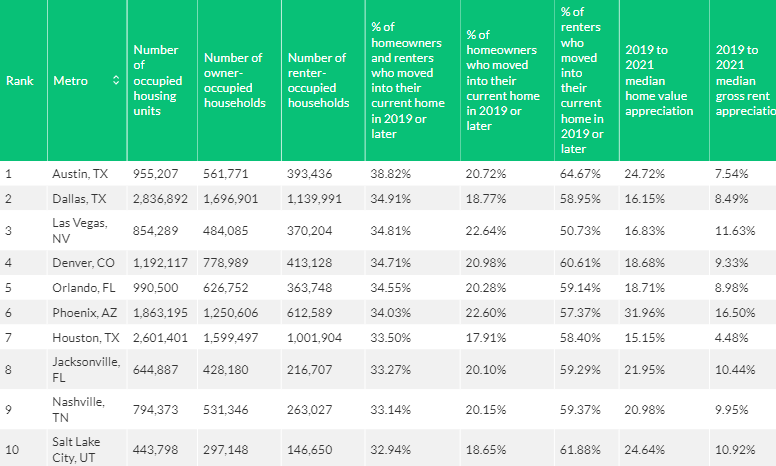Moving can be a challenge, financially, physically, and mentally, regardless of whether you own or rent a home. A new study from LendingTree found that the share of recent movers can vary significantly by place, and that renters are more than three times as likely to have recently moved than homeowners.
While inflation and high housing costs can make relocating extremely expensive, there are some that may move more often than others and some that live in the same home for decades, but not everyone can stay in one house that long.
LendingTree analyzed U.S. Census Bureau data to determine the largest and smallest share of homeowners and renters—individually and combined—in the nation’s 50 largest metropolitan areas who moved into their current home in 2019 or later.

Key Findings:
- The Austin, Texas, Dallas, and Las Vegas metros have the largest share of recent movers. In these metros, an average of 36.18% of homeowners and renters reported moving into their current homes in 2019 or later. Conversely, Pittsburgh, Buffalo, NY, and New York City have the smallest share of homeowners and renters who recently moved. In these metros, an average of 21.75% moved into their current homes in 2019 or later. Across the 50 largest metros, an average of 28.97% of homeowners and renters moved into their current place in 2019 or later.
- Renters are more than three times as likely to have recently moved than homeowners. On average, 50.96% of renters across the nation’s 50 largest metros moved into their current homes in 2019 or later, versus an average of 16.76% of homeowners.
- Looking solely at homeowners, the Las Vegas, Phoenix, and Tampa, FL, metros have the largest share that moved in 2019 or later. An average of 22.14% of homeowners in these metros moved into their current houses in 2019 or later. That’s nearly double the 12.22% average among the three metros with the smallest share of recent homeowners who moved — San Jose, CA, Pittsburgh, and Los Angeles.
- The largest share of renters in the 50 largest metros who recently moved live in Austin, Salt Lake City, and Denver. In these three metros, an average of 62.39% of renters moved into their current homes in 2019 or later—11.43 percentage points higher than the 50-metro average. The metros with the smallest share of renters who recently moved are New York, Los Angeles, and Riverside, CA. An average of only 35.75% of renters in these metros moved into their current homes in 2019 or later.
- Metros where a larger share of homeowners have recently moved tend to experience more significant home price appreciation. More movement among homebuyers can reduce the supply of homes for sale in a given area and cause prices to increase. But while there is a strong correlation between the share of homeowners who recently moved and home price appreciation, there’s a much weaker correlation between the share of renters who recently moved and rent appreciation. This shows how buying and renting markets don’t always behave the same way—even if they are related.
Top 10 metros where the largest share of homeowners and renters moved in 2019 or later:
- Austin, TX
- Dallas
- Las Vegas
- Denver
- Orlando, FL
- Phoenix
- Houston
- Jacksonville, FL
- Nashville, TN
- Salt Lake City
Top 10 metros where the smallest share of homeowners and renters moved in 2019 or later:
- Pittsburgh, PA
- Buffalo, NY
- New York
- Detroit
- Hartford, CT
- Providence, RI
- Philadelphia
- New Orleans
- Riverside, CA
- St. Louis

Why renters tend to move more than homeowners
As the study shows, a larger share of recent movers are renters than homeowners. But why?
According to LendingTree's findings, one short-term reason is that owning a house is typically much more expensive than renting one. This can give renters more freedom to leave their homes, as they don’t need to spend as much time saving for homebuying costs like a down payment or mortgage fees.
Renters also don’t have to deal with the often costly and potentially time-consuming hassle of selling a home. Instead, they can more easily pack up and move once their lease expires. But, homeowners who live in one place long enough to pay off their mortgages—or who otherwise end up without one—typically spend less on housing costs than renters.
This isn’t to say that moving is necessarily cheap and easy for renters, or that homeowners never have financially sound reasons to leave their current houses. On the contrary, moving can be expensive regardless of one’s homeowner status. Similarly, renters and owners may find themselves forced out of their current homes, even if they’d prefer to keep them.
To read the full report, including more data, charts, and methodology, click here.

 DSNews The homepage of the servicing industry
DSNews The homepage of the servicing industry









